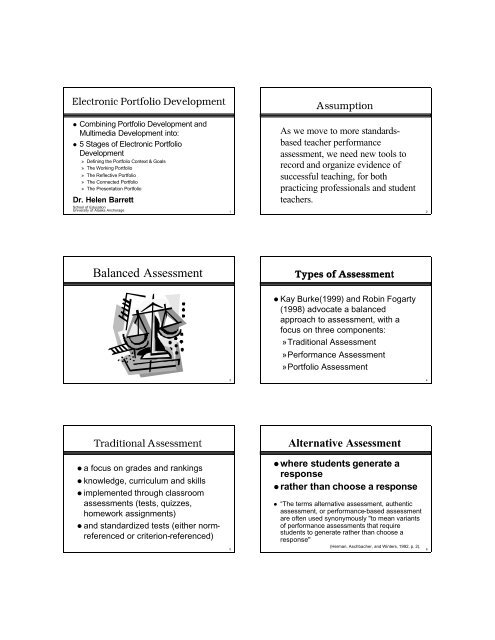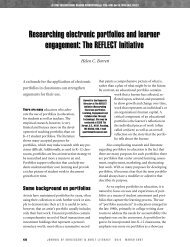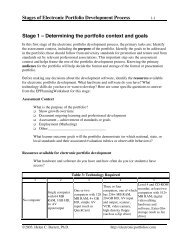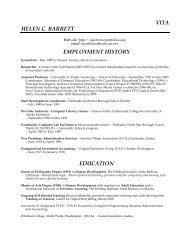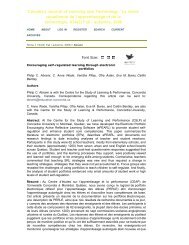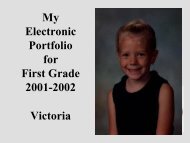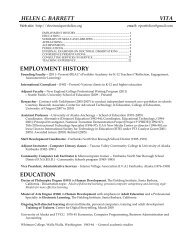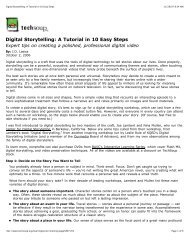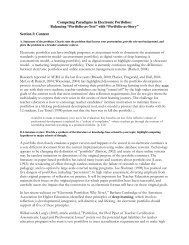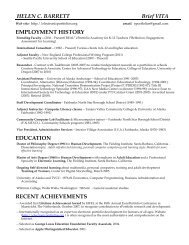Balanced Assessment - Dr. Helen Barrett's Electronic Portfolios
Balanced Assessment - Dr. Helen Barrett's Electronic Portfolios
Balanced Assessment - Dr. Helen Barrett's Electronic Portfolios
You also want an ePaper? Increase the reach of your titles
YUMPU automatically turns print PDFs into web optimized ePapers that Google loves.
<strong>Electronic</strong> Portfolio DevelopmentAssumption• Combining Portfolio Development andMultimedia Development into:• 5 Stages of <strong>Electronic</strong> PortfolioDevelopment» Defining the Portfolio Context & Goals» The Working Portfolio» The Reflective Portfolio» The Connected Portfolio» The Presentation Portfolio<strong>Dr</strong>. <strong>Helen</strong> BarrettSchool of EducationAs we move to more standardsbasedteacher performanceassessment, we need new tools torecord and organize evidence ofsuccessful teaching, for bothpracticing professionals and studentteachers.University of Alaska Anchorage 12<strong>Balanced</strong> <strong>Assessment</strong>Types of <strong>Assessment</strong>• Kay Burke(1999) and Robin Fogarty(1998) advocate a balancedapproach to assessment, with afocus on three components:»Traditional <strong>Assessment</strong>»Performance <strong>Assessment</strong>»Portfolio <strong>Assessment</strong>34Traditional <strong>Assessment</strong>• a focus on grades and rankings• knowledge, curriculum and skills• implemented through classroomassessments (tests, quizzes,homework assignments)• and standardized tests (either normreferencedor criterion-referenced)5Alternative <strong>Assessment</strong>•where students generate aresponse•rather than choose a response• “The terms alternative assessment, authenticassessment, or performance-based assessmentare often used synonymously "to mean variantsof performance assessments that requirestudents to generate rather than choose aresponse"(Herman, Aschbacher, and Winters, 1992, p. 2).6
Performance <strong>Assessment</strong>Portfolio <strong>Assessment</strong>• a focus on observable results andstandards, application and transfer• implemented through» Standards» Tasks» Criteria» Scoring rubrics• a focus on growth and developmentover time• implemented through selection,reflection and inspection ofclasswork• Including goal-setting and selfevaluation78Difference between performanceassessments and portfoliosWhat is a Portfolio?• A portfolio is a container that holdsexamples of student or teacher work(the "artifacts") and reflections on thatwork that transforms the artifacts into"evidence" of achievement.• Many of those artifacts could be theresults of performance assessmentswith associated evaluations andreflections.9•A purposeful collectionof students' work thatillustrates efforts,progress, andachievement (NW Eval Assoc.)10Why use <strong>Portfolios</strong>?Traditional portfolios•provides a richer pictureof student performancethan can be gained frommore traditional, objectiveforms of assessment11•traditional standards-basedportfolios are 3-ringnotebooks, organized withdividers and sections fordocuments demonstratingeach standard (Campbell, et.al., 1997)12
What is a portfolio?• a purposeful collection of student work thatdemonstrates effort, progress and achievement (basedon standards)• provides a richer picture of student performance thancan be gained from more traditional, objective forms ofassessment• traditional standards-based portfolios are 3-ringnotebooks, organized with dividers and sections fordocuments demonstrating each standard(Campbell, et.al., 1997)What is an <strong>Electronic</strong> Portfolio?• uses electronic technologies as the container• which allows students/teachers to collect andorganize portfolio artifacts in many mediatypes (audio, video, graphics, text)• using hypertext links to organize thematerial• connecting evidence to appropriate standards(in a standards-based portfolio)1314<strong>Electronic</strong> or Digital Portfolio?What is a teaching portfolio?• An <strong>Electronic</strong> Portfolio contains artifactsthat may be in analog form, such as avideo tape, or may be in computerreadableform• A Digital Portfolio contains artifacts thathave been transformed into computerreadableform (digitized/scanned/input)“A teaching portfolio is the structured,documentary history of a set of coachedor mentored acts of teaching,substantiated by samples of studentportfolios, and fully realized only throughreflective writing, deliberation, andconversation.” (Shulman, 1998)1516Professional <strong>Portfolios</strong> for TeachersWilcox & Tomei (1999) Christopher-Gordon Publishers, Inc.<strong>Dr</strong>. Mary Diez’ Metaphors(Alverno College)…extends the possibilities forportfolios in education by goingbeyond assessment, learning,and professional development tothe use of the portfolio asa living history of ateaching-learning life. (p.5)17The Portfolio as:• Mirror• Map• SonnetCaptures the reflective nature of theportfolio. Allows students to “see”themselves over timeCreating a plan and setting goalsProvides a framework, but thecontents can showcase creativityand diversity18
<strong>Dr</strong>. Mary Diez’ Metaphors(Alverno College)The portfolio asMirrorCaptures the reflective nature of the portfolioAllows students to “see” themselves over time<strong>Dr</strong>. Mary Diez’ Metaphors(Alverno College)The portfolio asMapCreating a plan and setting goalsDiez, Mary (1994) “The Portfolio: Sonnet, Mirror and Map” in Burke, Kay, ed. (1996) Professional <strong>Portfolios</strong>. Skylight Training & Publishing 19Diez, Mary (1994) “The Portfolio: Sonnet, Mirror and Map” in Burke, Kay, ed. (1996) Professional <strong>Portfolios</strong>. Skylight Training & Publishing 20<strong>Dr</strong>. Mary Diez’ Metaphors(Alverno College)Financial or Professional Portfolio?The portfolio asSonnetProvides a framework, but the contentscan showcase creativity and diversity•A financial portfolio documentsthe accumulation of fiscal capitalor monetary assets•A professional portfoliodocuments the development ofhuman capital or intellectualassetsDiez, Mary (1994) “The Portfolio: Sonnet, Mirror and Map” in Burke, Kay, ed. (1996) Professional <strong>Portfolios</strong>. Skylight Training & Publishing 2122Campbell, Melenyzer, Nettles, & Wyman (2000).Portfolio and Performance <strong>Assessment</strong> in Teacher Education.Boston: Allyn & Bacon.Campbell, Melenyzer, Nettles, & Wyman (2000).Portfolio and Performance <strong>Assessment</strong> in Teacher Education.Boston: Allyn & Bacon.“A portfolio is not merely a collection ofcourse projects, assignments, videotapes,and pictures designed to impresssomeone. If it is to meet its full potential,a portfolio must be organized, goal-driven,performance-based evidence thatindicates the attainment of the knowledge,skills, and attitudes needed to be ateacher.” (p.21)“We have found that as students progressthrough a teacher education program thathas a portfolio assessment system, theyincreasingly understand the power andpotential of portfolios for giving direction toreflect on throughout their professionallives.” (p. x)2324
Scrapbook or portfolio?“...Tom Bird...asked us to think about thedistinction between the teachers’ filingcabinet and the teachers’ portfolio. Asteachers, we accumulate a great deal ofdocumentation of our work. Butdepending on the case we have tomake, we draw from the filing cabinetand create a particular portfolio.”(Shulman, 1998)Is it a portfolio?•Or is it anelectronicallystored collection ofstudent work?2526Types of <strong>Portfolios</strong>Purposes for <strong>Portfolios</strong>Hartnell-Young & Morriss (1999) Digital Professional <strong>Portfolios</strong> for Change. Skylight• Working <strong>Portfolios</strong>-an intentional collection of work guided by learningobjectives• Display, Showcase, or Best Works<strong>Portfolios</strong> - demonstrate the highest level ofachievement - a celebration of learning• <strong>Assessment</strong> <strong>Portfolios</strong>- to document student learning on specific curriculumoutcomes27Form at ive(develop mental)Pu rpo se s1. Pr ofess iona lD eve lopm entPlann ing2. R eco r dingC ont inu ingPr ofess iona lD eve lopm ent3. C elebr ation ofAchieve m entsSummat ive(assessment )Pu rposes4. U nive r sityAd mi ssion5. M eet ing C ou r seR equ irem ents6. Pe rfo rm anceR eview &P rom otion7. P rofess iona lC er tificat ion &R eg istr ationMar keti ngPu rpo se s8. Job App licat ion9. "C old C alling "10. Organ izat iona lCapab ility28LearningPortfolioPromotes teacherref lection andowner ship o ver thelearn ing process.Portfolio Purposes (p.9)Ass essme ntPortfolioPr esen tseducationalorgani zations withinformation abou t atea cher 'seffect iveness.Em ploymentPortfolioProvidespro spe ctiveemployers withinformat ion abou t atea cher 's suitabilityfor a po sition.Portfolio Authors and AudiencesLear ni ngPortfoli os(p.10)Ass ess ment<strong>Portfolios</strong>Author Teache r Teacher/Edu ca tio nalOrganizationAudie nce Teache r/Colle agues,Pare nts, &Stude ntsEdu ca tio nalOrganization/Pub licEmploym entPortf ol iosTeach er/Pr os pectiveEmp loyerPr os pectiveEmp loyersWolf, Kenneth (1999) Leading the Professional Portfolio Process for Change . Skylight Training & Publishing, Inc.29Wolf, Kenneth (1999) Leading the Professional Portfolio Process for Change . Skylight Training & Publishing, Inc.30
Benefits of Developing Multimedia <strong>Portfolios</strong>Hartnell-Young & Morriss (1999) Digital Professional <strong>Portfolios</strong> for Change. SkylightBenefits of Professional <strong>Portfolios</strong>Benefits from the organization’s point of view• increases confidence of teachers in implementing technology• students see a positive role model when teachers work withtechnology in this way• enhances the “learning organization”: students and teacherslearn together when all create portfolios• increases knowledge of the “intellectual capital”• the product can be used in marketing the capabilities of theorganization(p. 25)37• Documentation of Growth & Achievement• Self-assessment of Professional Goals• Staff Development• Employment Interviews• Advancement• Performance Reviews• Lifelong Learning Tool• Source of Affirmation & Pride• Sharing with StudentsRolheiser, Bower, & Stevahn (inpress) The Portfolio Organizer:A Guide for Decision Making38<strong>Electronic</strong> Portfolio Development isbased on two bodies of literature:CollectionPortfolio DevelopmentLiterature• Collection• Selection• Reflection• Projection(or Direction)(Danielson & Abrutyn (1997)An Introduction to Using <strong>Portfolios</strong> in theClassroom. Alexandria: Association forSupervision and Curriculum Development.Multimedia DevelopmentLiterature• Assess/Decide• Design• Develop• Implement• EvaluateIvers, K., & Barron, A. E. (1998) MultimediaProjects in Education . Englewood, CO: LibrariesUnlimited, Inc.39• The primary activity of a working portfolio.• Don’t save everything!• Purpose and audience and future use ofartifacts will determine content.Danielson & Abrutyn (1997). An Introduction to Using <strong>Portfolios</strong> in the Classroom. ASCD40SelectionReflection• Students examine what has beencollected to decide what should be movedto a more permanent assessment ordisplay portfolio.• Criteria should reflect the learningobjectives of the curriculum.(Danielson & Abrutyn [ASCD], 1997, p. 13)• This is where many electronic portfolios end!41• Students articulate their thinking abouteach piece in their portfolio.• Through this process of reflection,students become increasingly aware ofthemselves as learners.• Use reflective prompts.• Include reflections on every piece plusoverall reflection on entire portfolio.(Danielson & Abrutyn [ASCD], 1997, pp.15-16)42
ReflectionProjection• “The use of portfolios not only helpsstudents make better progress onthe skills in the curriculum; it alsohelps them develop critical skillssuch as reflection and selfevaluationwhich are fundamentalto excellence in any walk of life.”(Danielson & Abrutyn [ASCD], 1997, p. 26)• Looking ahead and setting goals forthe future.• Students see patterns in their work.• These observations can helpidentify goals for future learning.(Danielson & Abrutyn [ASCD], 1997, p. 18)4344The Portfolio Connection(Burke, Fogarty, Belgrad, 1994)The Portfolio Connection(Burke, Fogarty, Belgrad, 1994)• PROJECT purposes• COLLECT andorganize artifacts• SELECT key artifacts• INTERJECTpersonality• REFLECTmetacognitively• INSPECT to self-assess• PERFECT and evaluate• CONNECT andconference• INJECT/EJECT toupdate• RESPECTaccomplishments•PROJECT purposes- the “big picture”goals for the portfolioProjecting is focusing.4546The Portfolio Connection(Burke, Fogarty, Belgrad, 1994)•COLLECT and organize theartifactsCollection is abundance.The Portfolio Connection(Burke, Fogarty, Belgrad, 1994)•SELECT key artifacts- contents of the portfolio- prioritizeSelection is abandonment.4748
The Portfolio Connection(Burke, Fogarty, Belgrad, 1994)•INTERJECT personality- cover, design, layouts- personal touchInterjection is style and flair.The Portfolio Connection(Burke, Fogarty, Belgrad, 1994)•REFLECT metacognitively- label each artifact formeaning and value- give voice to why an artifactis included49Reflection is a mirror into the self.50Reflection and Learning"We do not learn fromexperience.We learn from reflecting onexperience.”-John Dewey…from Kay Burke (1997)Designing Professional <strong>Portfolios</strong> for Change"Without written commentaries, explanationsand reflections, the portfolio is no more thana notebook of artifacts or a scrapbook ofteaching mementos. Such a portfolio doesnot reveal the criteria for collecting thecontents, the thoughts of why the itemswere selected, or what the teacher and thestudents learned."5152The Portfolio Connection(Burke, Fogarty, Belgrad, 1994)•INSPECT to Self-Assess- meet long-term & short-term goals- evidence of strengths & weaknessesInspection ensures one is oncourse.The Portfolio Connection(Burke, Fogarty, Belgrad, 1994)•PERFECT and Evaluate- fine-tuning the content- getting ready for gradingPerfecting is to make a polishedfinal draft or a finished product.5354
The Portfolio Connection(Burke, Fogarty, Belgrad, 1994)•CONNECT and Conference- share the finished productwith someone- use portfolio as basis formeaningful dialogueConnecting is conversing.The Portfolio Connection(Burke, Fogarty, Belgrad, 1994)•INJECT/EJECT to update- keeps portfolio manageable- regular honing keeps theportfolio freshInjecting/ejecting is the cycle of theportfolio.5556The Portfolio Connection(Burke, Fogarty, Belgrad, 1994)•RESPECT Accomplishments- formal exhibition before anaudienceRespecting is celebration.The Portfolio Connection(Burke, Fogarty, Belgrad, 1994)• Three Options for Portfolio Development•Essential Portfolio• Collect, Select, Reflect•Expanded Portfolio• Project, Collect, Select, Reflect, Perfect, Connect•Elaborated Portfolio• Project, Collect, Select, Interject, Reflect, Inspect,Perfect, Connect, Inject/Eject, Respect5758Portfolio Organizer(decision-making points, not a step-by-step process)Multimedia Development• Purpose, Type, Audience, Time Frame• Categories for Entries• Criteria for Entries• Work Samples• Reflections• Storing and Organizing <strong>Portfolios</strong>• Sharing the Learning: Conferences & Responses• Goal Setting• Self-Evaluation• Getting StartedRolheiser, Bower, & Stevahn (in press) The PortfolioOrganizer: A Guide for Decision Making59InstructionalDesign Stages• Assess or Decide• Design or Plan• Develop• Implement• Evaluate• Present or PublishMultimediaAuthoring Skills• Use Authoring Toolto structure navigation• Scan Graphics• Digitize Sound• Digitize Video• Write CD-R/W orPost to WWW60
Combining Portfolio Development& Multimedia DevelopmentThe Phases in Portfolio Development(Burgess & Holmes 2000)PortfolioDevelopment•Purpose &Audience•Collect•Interject•Select•Reflect, Direct•Perfect, Inspect•Connect•Respect(Celebrate)<strong>Electronic</strong> PortfolioDevelopmentDefining the PortfolioContext & GoalsThe Working PortfolioThe Reflective PortfolioThe Connected PortfolioThe Presentation PortfolioMultimediaDevelopment•Decide, Assess•Design, Plan•Develop•Implement•Evaluate•Present•PublishPhaseAnxietyUncertaintyConnectionsAwarenessPresentationDescriptionAnxiety about the unknowns. Anxious about process, product andoutcomes.Uncertainty about what to document, how to document, when todocument.Thoughtful reflection and analysis about the work they do.Heightened awareness of how much has been accomplished asassembled artifacts are reviewed.Professional pride as portfolio takes shape and becomes a finishedproduct. A sense of accomplishment.Evaluation / Enabler. Has developed sufficient confidence to assist othersreflections through the portfolio process.Burgess, G. W. & Holmes, B. D. 2000. Producing a professional portfolio.© 1999, <strong>Helen</strong> C. Barrett, Ph.D. 61Guidebook for success. Conway, Arkansas: River Road Press.62Stage 1Defining the Portfolio Context & Goals• Portfolio DevelopmentPurpose, Audience• Multimedia DevelopmentDecide, Assess• Identify the purpose of the portfolio.• Identify the learner outcome goals or standards• Identify the resources available• Identify the hardware and software• Identify time, staff development, etc.• Assess the technology skills of students/teachers• Identify the audience for the portfolio63Planning Documents• http://helenbarrett.com/workshop/files for hands-on workshop plusplanning documents• http://helenbarrett.com/EPDirections.pdfa paper by David Gibson that outlines issuesbetween generic tools and computersystems approaches• http://helenbarrett.com/EPpedissues.pdfa list of pedagogical issues to address whenplanning for electronic portfolios.64Stage 1Appropriate Technology Tools & StrategiesElements of Portfolio Planning• Use whatever software tools are currently being used to collectartifacts, storing them on a hard drive, a server, or videotape.Set up electronic folders for each standard to organize the artifacts(any type of electronic document). [Level 1] AND• Use a word processor, database, hypermedia software or slideshowto articulate the standards to be demonstrated in the portfolioand to organize the artifacts. [Level 2] OR• Use an HTML editor to articulate the standards to bedemonstrated in the portfolio and to organize the artifacts. [Level 4]OR• Use a multimedia authoring program to organize by thestandards to be demonstrated in the portfolio. [Level 5]65•Purpose•Audience•Process (not Product)66
<strong>Portfolios</strong>Clarifying, Constructing and Enhancing (Johnson & Rose, 1997)<strong>Portfolios</strong>Clarifying, Constructing and Enhancing (Johnson & Rose, 1997)• “When we only focus on portfolios as aproduct, we’ve missed their potential power,which comes from the process of creatingthem. It is the decision-making processconcerning which entries are placed in thecollection and why each was selected thatactually builds the power of the portfolio bypersonalizing education for the student (DeFina,1992; Glazer & Brown, 1993; Herman et al., 1992) (p.8)• Benefits for all participants:» Students accept responsibility for their ownlearning» Shift the role of the teachers» Merge assessment and instruction into thesame tasks» Hold schools accountable for complex learning» Create dynamic school climates (p.11)6768<strong>Portfolios</strong>Clarifying, Constructing and Enhancing (Johnson & Rose, 1997)A few words about the primaryaudience for the portfolio• Process of creating contents of portfolios ispart of curriculum, instruction andassessment• A portfolio approach to assessment capturesthe best each student has to offer,encourages the use of many ways toevaluate learning, and has an integrity andvalidity that no other type of assessmentoffers. (Valencia, 1990; Wiggins, 1993) (p.17-18)69• If you focus on electronic portfolios foremployment AND the primary audience(principals) doesn't look at it, then studentsbecome frustrated.• If you focus on electronic portfolios forevidence of professional development, ANDthe primary audience (the student & faculty)uses the portfolio to validate that growth,then students become empowered.70Confusion of purpose(Breault, AERA, 2000)“High Stakes <strong>Portfolios</strong>”• Research on metacognition in preserviceportfolio development has shown thatfaculty and students see different purposesfor portfolios:• Students see portfolios as marketing tools• Faculty see portfolios as assessment andformative evaluation tools• The confusion of purpose can create• The move to “high stakesperformance” portfolios mayundermine the transformative natureof reflective portfolios.• Be aware of the conflicting purposesand values when developingportfolios(AERA, 2000)dissonnance.7172
Why use Standards in<strong>Portfolios</strong>?“Standards come alive whenthey are assessed throughperformance-based meanssuch as portfolios.”National Evaluation Systems (1997) Linking Standards and<strong>Assessment</strong>. (p.30)Organizing framework•Most states have adoptedstandards for both students,practicing teachers, and newteachers. These standards forman ideal framework for thinkingabout organizing an electronicportfolio.7374Campbell, Melenyzer, Nettles, & Wyman (2000).Portfolio and Performance <strong>Assessment</strong> in Teacher Education.Boston: Allyn & Bacon.“Some teacher educators believe thatstudents should impose their ownorganizational schemes on their portfoliodocumentation. Certainly when aportfolio is being designed solely as amarketing tool, this might be desirable.It would allow for the greatest flexibilityand enhance opportunities forindividuality and creativity.” (p. 21)Campbell, Melenyzer, Nettles, & Wyman (2000).Portfolio and Performance <strong>Assessment</strong> in Teacher Education.Boston: Allyn & Bacon.“However, when portfolios are being used by ateacher education program to focus the effortsof both faculty and students on achievingstandards for professional performance, itmakes more sense to organize at least mostof the portfolio around the chosen standards.The easiest way for your students to do this isto divide the portfolio into labeled sections,one for each of the standards.” (p.21)7576<strong>Electronic</strong> Portfolio Planning WorksheetStage 1What is the best electronicportfolio program???You will know you are ready for the next stagewhen:• You have identified the purpose and primaryaudience for your portfolio.• You have identified the standards or goals thatyou will be using to organize your portfolio.• You have selected the development software youwill be using and have completed the first stageusing that tool.77IT DEPENDS . . .• on the assessment context• and a variety of other factors, humanand technological, that exist in aclassroom, school or district.78
Two Directions in <strong>Electronic</strong>Portfolio DevelopmentGeneric tools approachGeneric toolsapproach• Using off-the-shelfsoftwareCustomizedsystems approach• Designing anetworked system• Buying a proprietarysoftware package79• <strong>Portfolios</strong> with reflections and artifacts thatmore closely emulate the traditional 3-ringbinder• Structure imposed by developer and/orsoftware -- flexibility and creativity• Low cost for infrastructure• Higher cost for training• Student can continue developing portfolioonce out of the system80Customized systems approachTwo Directions in <strong>Electronic</strong>Portfolio Development• Record-keeping system that can beused to collect reflections and artifacts• Highly structured using online database-- limited flexibility and creativity• High cost for infrastructure• May be a lower cost for training,depending on system design• What happens to portfolio whenstudents leave the system?81Generic toolsapproach• Advantages» Cost» Use what is widelyavailable» Easy to get started» Easy to maintain• Disadvantages» Ability to aggregate data» May be difficult to shareonline with securityCustomized systemsapproach• Advantages» Ability to aggregate data» Accessibility» Security• Disadvantages» Cost» Infrastructure requirements82Generic Construction Tools(off-the-shelf software)Stage 2The Working Portfolio• Relational Data Bases, - FileMaker Pro 4.0 or Microsoft Access• Hypermedia "card" formats, such as HyperStudio, HyperCard,Digital Chisel, or SuperLink + commercial templates available.• Multimedia authoring software, such as MacromediaAuthorware, Macromedia Director• Network-compatible hypermedia:•HTML/WWW Pages•Adobe Acrobat (PDF)• Office “Suite” -- Multimedia slide shows, such as MicrosoftPowerPoint, AppleWorks, and Microsoft WordSee article in Learning & Leading with Technology,• Portfolio DevelopmentCollect, Interject• Multimedia DevelopmentDesign, Plan• Identify the content of portfolio items and the type ofevidence to be collected• Select the most appropriate software development toolsbased on the portfolio context and the resources available.• Identify the storage and presentation/publishing mediummost appropriate for the situation• Gather the multimedia materials that represent learningachievement. Interject personality into the portfolio design.April, 2000 8384
Stage 2Appropriate Technology Tools & StrategiesStage 2Appropriate Technology Tools & Strategies• Select software to organize selected artifacts:• Use Word Processing, Slide Shows, Hypermedia, orDatabase programs to list and organize the artifacts thatwill be placed in the Working Portfolio. [Level 2]OR• Use an HTML editor (or any tool that is normally used)to develop and organize the artifacts for the WorkingPortfolio. [Level 4]OR• Use a multimedia authoring program to organize theselected artifacts. [Level 5]85• Convert student work into digital format• Use appropriate multimedia to add style &individuality to portfolio.• Use a scanner (or camera) to digitize images[Level 2]• Use a microphone and sound digitizing programto digitize audio artifacts [Level 4]• Use a video camera/VCR, digitizing hardware andsoftware to digitize video artifacts [Level 5]86Types of Evidence in a PortfolioProductions• Artifactsdocuments produced during normal academic work• Reproductionsdocuments of student work outside the classroom• Attestationsdocumentation generated about student’s academic progress• Productionsdocuments prepared just for the portfolios» Goal statements» Reflections» Captions Barton, James & Angelo Collins (1997) Portfolio <strong>Assessment</strong>:A Handbook for Educators. Dale Seymour Publications, pp. 4 -587• Goal StatementsStudent’s personal interpretations of eachspecific purpose for the portfolios• Reflective StatementsStudents write as they review and organizethe evidence in their portfolios• CaptionsStatement attached to each piece of portfolioevidence, articulating what it is, why it isevidence, and of what it is evidence.Barton, James & Angelo Collins (1997) Portfolio <strong>Assessment</strong>:A Handbook for Educators. Dale Seymour Publications, pp. 5 -688<strong>Electronic</strong> Portfolio Planning WorksheetStage 2Stage 3The Reflective PortfolioYou will know you are ready for the next stagewhen:• Portfolio DevelopmentSelect, Reflect, Direct• Multimedia DevelopmentDevelop• You have a collection of digital portfolio artifacts thatrepresent your efforts and achievement throughout thecourse of your learning experiences.• You have used the graphics and layout capability of thechosen software to interject your personality into theportfolio artifacts.• Write general reflective statements on achieving eachstandard.• Select artifacts that represent achievement of thestandards or goals.• Write reflective statements for each artifact, elaboratingon why it was selected and its meaning and value in theportfolio.• It is time to turn this collection into a portfolio.89• From the reflections and feedback, set learning goals forthe future.90
A portfolio without reflections:•is just a multimedia presentation•or a fancy electronic resume•or a digital scrapbookStage 3Appropriate Technology Tools & Strategies• Use Word Processing, Slide Shows, Hypermedia, orDatabase programs to record the reflections and futuregoals that will become the Reflective Portfolio. [Level 2]OR• Use an HTML editor (or any tool that is normally used) torecord the reflections and future goals that will become theReflective Portfolio. [Level 4]OR• Use a multimedia authoring program to record thereflections and future goals that will become the ReflectivePortfolio. [Level 5]9192Campbell, Melenyzer, Nettles, & Wyman (2000).Portfolio and Performance <strong>Assessment</strong> in Teacher Education.Boston: Allyn & Bacon.Campbell, Melenyzer, Nettles, & Wyman (2000).Portfolio and Performance <strong>Assessment</strong> in Teacher Education.Boston: Allyn & Bacon.We also like the three questionssuggested by Van Wagenenand Hibbard (1998)”1. “What?”2. “So what?”3. “Now what?” (p.22)93“To use these questions, thestudent would firstsummarize the artifact thatdocuments the experience, inorder to answer the question“What?”(p.22)94Campbell, Melenyzer, Nettles, & Wyman (2000).Portfolio and Performance <strong>Assessment</strong> in Teacher Education.Boston: Allyn & Bacon.Campbell, Melenyzer, Nettles, & Wyman (2000).Portfolio and Performance <strong>Assessment</strong> in Teacher Education.Boston: Allyn & Bacon.Second, the student wouldreflect on what he or shelearned and how this leadsto meeting the standard,which answers thequestion “So what?” (p.22)“And third, the studentwould address implicationsfor future learning neededand set forth refinementsor adaptations, in order toanswer “Now what?”(p.22)9596
Setting goals for future learningOutcomes of <strong>Portfolios</strong>Hartnell-Young & Morriss (1999) Digital Professional <strong>Portfolios</strong> for Change. SkylightThis is the stage that turnsportfolio developmentinto powerfulprofessional development“Many people discover that one of the most important andlong-lasting outcomes of producing a portfolio is theself-esteem that comes from recording and reflecting onachievements and career success.“Experienced teachers and administrators are finding thatthe benefits of developing a portfolio include theopportunity for professional renewal through mappingnew goals and planning for future growth.” (pp. 9-10)9798<strong>Electronic</strong> Portfolio Planning WorksheetStage 3Stage 4The Connected PortfolioYou will know you are ready for the next stagewhen:• You have selected the artifacts that are going intoyour formal or presentation portfolio.• You have written the reflective statements andidentified learning goals for the future.99• Portfolio DevelopmentPerfect, Inspect,Connect• Multimedia DevelopmentImplement, Evaluate• Organize the digital artifacts using hypertext links.• Identify patterns through the "linking" process.• Final review and editing of the portfolio & goals.• Share the portfolios with an appropriate audience.• Use the portfolio to make instruction/learning or professionaldevelopment decisions.100Stage 4Appropriate Technology Tools & StrategiesLinking = Learning• Convert word processing, database or slide showdocuments into either PDF [Level 3]or HTML [Level 4] AND• Create hypertext links between goals, student worksamples, rubrics, and assessment.Insert multimedia artifacts [Level 3 & 4 ]OR• Create a hypermedia presentation using a multimedia authoringprogram, creating links between goals, student work samples,rubrics, and assessment. [Level 5]101• The transformation from “artifacts” to“evidence” is not always clear.• Linking reflections to artifacts makes thisthinking process more explicit.• The ability to create links from multipleperspectives (and multiple goals)overcomes the linearity of twodimensionalpaper portfolios.102
Turning Artifacts intoEvidence of LearningEvidence =Artifacts +Reflection +Validation (Feedback)Benefits of Digital <strong>Portfolios</strong>Hartnell-Young & Morriss (1999) Digital Professional <strong>Portfolios</strong> for Change. Skylight“Hypertext allows for deeperunderstanding and explanation throughlinks that go from summary statementsto complete documents, related items,and reflections. In addition to displayingartifacts efficiently, links can allow thecollection of material in a PersonalArchive to become broader and morethoughtful.” (pp. 23-24)103104Benefits of Digital <strong>Portfolios</strong>Hartnell-Young & Morriss (1999) Digital Professional <strong>Portfolios</strong> for Change. Skylight“Developing a multimedia portfoliocan be challenging, requiringteachers to model learning, developtechnology skills along with theirstudents, and share the results witha wider audience. (p. 24)105<strong>Electronic</strong> Portfolio Planning WorksheetStage 4You will know you are ready for the next stagewhen:• Your documents are converted into a format that allowshypertext links and you can navigate around yourdocument using those hypertext links.• You have inserted the appropriate multimedia artifactsinto the document.• You are ready to share your portfolio with someone elseand/or you are ready to publish your portfolio.106Stage 5The Presentation PortfolioStage 5Appropriate Technology Tools & Strategies• Portfolio DevelopmentRespect (Celebrate)• Multimedia DevelopmentPresent, Publish• Record the portfolio to an appropriatepresentation and storage medium.• Present the portfolio before an audience (realor virtual).• Evaluate the portfolio's effectiveness in lightof its purpose and the assessment context.• Post the portfolio to WWW serverOR• Write the portfolio to CD-ROMOR• Record the portfolio to videotape107108
Know Your Audience•What are the issues in postingportfolios to the Internet?»Publishing a reflective portfolio onthe WWW may inhibit the qualityof the reflection»Intellectual property rights»Security and accessA year-long <strong>Electronic</strong> Portfoliodevelopment timelineStageSep Oct Nov Dec Jan Feb Mar Apr MayI XX (x)IIXX XX XX XX XX XX XX XXIII (x) (x) (x) XX (x) (x) (x) (x) XXIV X (x) XXV(x) XX109110Wright State University• Graduate students create their electronicportfolios with whatever tools they have• Must demonstrate four specific outcome typesfrom their program standards• Students write a two-page synopsis of theirportfolios, which the program keeps (+ resumé)• Former students used to create a videotape“tour” to document their “paper-based”portfolios, which the program kept (NECC, 1999)111A few final words112Become a “digital pack rat”Identify standards• Set up an electronic filing system• Use “high density storage” devices- Zip disks, Jaz disks- CD-R, DVD-RAM• Don’t leave the “collection/selection”until the last minute• Plan for an electronic portfolio from thebeginning of the program• Use for portfolio organization• Set up “folders” to store artifact for eachstandard• Suggested Standards:NCATE/ISTE (Technology)INTASC (Pre-service)NBPTS (National certification)State or Local Teaching Standards113114
Select artifactsWrite reflective statements• Select the artifacts that demonstrateachievement of each standard• Possible types of artifacts to include:• significant papers, projects;• evaluations from all practicum/field experiences;• professional correspondence, letters of reference;• letters of recognition, awards, certificates, etc.;• samples of effective and reflective writing;• stories, journal entries, articles, manuals ;• photographs, drawings, sketches;• lesson plans/curriculum that you have created;• audio, video, or other electronic evidence;115• For each artifact(in a Learning/Working Portfolio)• For each standard(in an <strong>Assessment</strong> Portfolio)• Could set up a standard form to be completed» Using a database program» Using a PDF form with “fields”116Create an outline or storyboard• Use word processor with outlining(such as Microsoft Word)OR• Use slide show with outlining(such as PowerPoint)OR• Use mapping software(such as Inspiration)117Create Table of Contents• Divide into sections:» Introduction– Acknowledgement– Table of Contents» The Standards and Reflections» The artifacts• Create a different Table of Contents for» an <strong>Assessment</strong> Portfolio» an Employment Portfolio118Create a portfolio matrixConvert Artifacts to PDF• Single page overview/cross referenceif individual artifacts documentachievement of more than one standard• Use spreadsheet or table in wordprocessor• Create PDF files from word processingor slide show files (or any application)• Use PDF Writer• OR convert Postscript files withAcrobat Distiller(print to file)119120
Edit PDF Files in ExchangeCreate Multimedia Files• Edit Pages inExchange» Insert pages» Extract pages» Replace pages» Delete pages» Move pages» Crop pages» Rotate pages• Page Actions» Use forms» Add web links» Add multimediaobjects– Sound– QuickTime movies» Notes» Navigation tools121• Digitize and edit sound clips- use sound editing software:Sound CompanionKaboom!• Digitize and edit video clips- use video editing software:Movie Player Pro, Avid Cinema,Adobe Premiere, Apple’s new Final Cut122Navigation• Organize portfolio with hypertext linksbetween– Standards– Artifacts– reflections• Create bookmarks & thumbnails• Add movie links• Insert sound clipsPublish Portfolio• Record to appropriate mediumFloppy disk (no multimedia)CD-RecordableWWW serverVideo tapeDVD (coming soon)• Add “buttons” with Forms tool123124Technology Skills for developing<strong>Electronic</strong> <strong>Portfolios</strong> in AcrobatDon’t double your learning!1. Converting files from any application to PDF using PDFWriter orAcrobat Distiller2. Scanning/capturing and editing graphic images3. Digitizing and editing sound files4. Digitizing and editing video files (VCR -> computer)5. Organizing portfolio artifacts with Acrobat Exchange, creatinglinks & buttons6. Organizing multimedia files and pre-mastering CD-ROM usingJaz disks7. Writing CD-Recordable disc using appropriate CD masteringsoftware8. Recording computer images with narration to video tape(computer -> VCR)125•When learning new tools,use familiar tasks;•When learning new tasks,use familiar tools.Barrett, 1991126
Remember the portfolio is aunique document......illustrating your achievements as an educator. It should:• identify and reflect positively on relevant learning achievements• critically analyze experiences and articulate the learning achieved• demonstrate increased awareness of own potential and aspirations• demonstrate improved self-confidence to develop own learning• identify academic and professional development• demonstrate skills, knowledge and understanding gain from coursework• demonstrate skills, knowledge and understanding gain from the practicum• demonstrate skills, knowledge and understanding gain from relatedprofessional work experiences• critically reflect your thoughts and self assessment• - from UAA Adult Education Portfolio Handbook, 1998127Above all else:May yourelectronic portfoliosbecome dynamiccelebrations of learningacross the lifespan!128A great quote on portfolios foradult learners:<strong>Helen</strong> C. Barrett, Ph.D.• …helping to honor the student learningprocess while learning how to recordand present it!• …helping students honor their learningthrough using portfolios to capture,honor, understand, and use theirlearning for a better life and a betterworld.-- <strong>Dr</strong>. Joanie DominickKennesaw State University129• Web Site on <strong>Electronic</strong> <strong>Portfolios</strong>http://transition.alaska.edu/www/portfolios.htmlhttp://electronicportfolios.comhttp://helenbarrett.com• Listserv:http://groups.yahoo.com/efolios• E-Mail: afhcb@uaa.alaska.edu130Learn about AcrobatAdobe PressISBN: 0201702843$31.50 (Amazon)A great tutorialIDG Books WorldwideISBN: 0764532421$31.99 (Amazon)A great referencePeachpit PressISBN: 0201354616$14.39 (Amazon)A “quick&dirty” guide131


